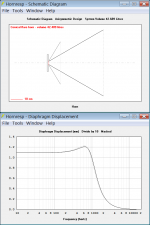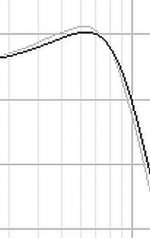If it's driven with the same voltage, SPL will be different. What would be interesting to see is what excursion is needed to reach a given SPL at some distance.
Quite recently I made a similar comparison: Acoustic Horn Design – The Easy Way (Ath4) (#7876)
Quite recently I made a similar comparison: Acoustic Horn Design – The Easy Way (Ath4) (#7876)
Last edited:
As you wish. Here are two horns. They have very different cutoffs, more than an octave and a half separation of the acoustic impedance slopes.
Well, it also depends on how easy the air can avoid being 'pushed away', which is of course easier with a faster opening. Aside from that, manufacturers got a lot different definitions on what the cut off is. A horn or WG with a low cutoff frequency is on paper so much more attractive and tempting. Some define it at -6dB, others at -10dB, a few even more. It's often completely irrelevant because the driver you want to use got down there neither any controlled dispersion nor an acceptable distortion, that's like the power rating of 10% THD on class A/B or class D amps, noone listens to that kind of distortion. Interestingly some tube amps can still sound enjoyable but that's the distortion spectrum and the softer limit than the hard cut off of the signal amplitude on the other amps.
Interesting. I thought:
Mouth area = cutoff
Depth = loading/gain
That's generally correct but that depends a lot on the construction of the horn. Diffraction horns can have a similar co frequency and still more gain than a WG, depending on how they shortened the horn. Diffraction horns often got a similar linearity like spherical horns but at a smaller size and a vastly better, more uniform, even dispersion in the whole usable frequency range.
There's another issue though, if the throat is very long, you get a high gain but it will beam on the upper end a lot. And that's the downfall of these 'perfect' spherical horns high-enders love so much. Some got such horn types quite well though, Le Cleach i.e.
Not really. Another example...Well, it also depends on how easy the air can avoid being 'pushed away', which is of course easier with a faster opening.
Attachments
Not really. Another example...
That's not surprising as the 'slow' opening one already opens very quickly, which makes the difference quite small. Aside from that, your simulation confirms what I've wrote.
It wouldn't make much of a difference in this case, most CDs got an Xmax of 0,2mm and I can't remember any CD driver with more than 0,5mm (was a 2" with 4" VC).
Attachments
Cutoff has to do with the rate of change as you move along the horn.
I took those models and put them on a compression driver to see what it's displacement would be like on each horn. As shown, they are similar.
What is your CO definition? When is a WG/horn cut off? I mean in figures/numbers.
//
Not really. Another example...
Why is the excursion linear down to LF? I have found that the excursion has to double each octave down to put out the same SPL. What about normalization if the driver needs eq at LF in a short wg? I think you need to account for this in the pictures.
mabat also correctly pointed out differences in output... This is not what I set out to do. The need to use EQ would simply have shown my point.docali said:What about normalization if the driver needs eq at LF in a short wg? I think you need to account for this in the pictures.
If only...TNT said:What is your CO definition? When is a WG/horn cut off? I mean in figures/numbers.
When selecting an existing device.. does cutoff apply to finite horns? What happens outside the bounds of Webster's equation? Is it the same for all horn types?
I don't apply the term to waveguides. I don't know what to expect when a number has been quoted by a manufacturer.. often lowering the cutoff doesn't have the expected effect. One of the best ways to know what you have is to measure it.
If you look at your impedance traces you see it indeed is. When the situation for the driver is in no way different from sitting in a WG/horn, you have to say that the "loading" is lost.
I dint understand why you keep holding this position - its so obvious and logical. Then the SQ impact under certain circumstances might not be that severe, but still...
//
I dint understand why you keep holding this position - its so obvious and logical. Then the SQ impact under certain circumstances might not be that severe, but still...
//
So when is the loading lost for a direct radiating midrange or a woofer, for example? It's exactly the same question. It's never lost. It's all about the drivers capabilities to produce required SPL in a given situation. As long as it is capable, there's simply no problem. I don't understand at all how can people still obsess about this.
Who ever looks at the radiation impedance for a woofer?? It is almost nil at the very low frequencies. So what? All that matters is whether is the woofer capable to produce the SPL required or not.
Who ever looks at the radiation impedance for a woofer?? It is almost nil at the very low frequencies. So what? All that matters is whether is the woofer capable to produce the SPL required or not.
Last edited:
There doesn't have to be a SQ impact.Then the SQ impact under certain circumstances might not be that severe,
Just look at the THD graphs which can be found at Voice Coil Testbench.
Keep in mind that Vance Dickason test CD's at 104dB, instead of the regular 94dB.
So subtract 10dB from the distortion to get a idea how it will perform against certain tweeters.
For tweeters and compressions drivers, the only thing I do is just look at the distortion curve (well and of course directivity).
You just want to look out for when the distortion suddenly rises up.
That being said, some drivers have a tendency to have irregular behavior around the Fs.
Which causes the Fs to shift. This effect is a lot more stable with drivers with ferrofluid.
Keep in mind that Vance Dickason test CD's at 104dB, instead of the regular 94dB.
So subtract 10dB from the distortion to get a idea how it will perform against certain tweeters.
For tweeters and compressions drivers, the only thing I do is just look at the distortion curve (well and of course directivity).
You just want to look out for when the distortion suddenly rises up.
That being said, some drivers have a tendency to have irregular behavior around the Fs.
Which causes the Fs to shift. This effect is a lot more stable with drivers with ferrofluid.
So when is the loading lost for a direct radiating midrange or a woofer, for example?
Attachments
What?
OK...
Natural loading (no added loading i.e. an acoustical transformation ratio 1:1)
Added loading (a wg/horn with an acoustical transformation ratio > 1:1)
as seen from the driver.
//
If it's driven with the same voltage, SPL will be different. What would be interesting to see is what excursion is needed to reach a given SPL at some distance.
Quite recently I made a similar comparison: Acoustic Horn Design – The Easy Way (Ath4) (#7876)
Nice graphs.
The SPL variation still needs to be EQ'd for a real system. It would be more interesting to EQ the system flat on axis 500-15K then see what the difference in excursion is across the FR. Even a 20dB (+/-10dB) total correction means 10x variation in drive voltage and 100x variation in applied power.
So when is the loading lost for a direct radiating midrange or a woofer, for example? It's exactly the same question. It's never lost. It's all about the drivers capabilities to produce required SPL in a given situation. As long as it is capable, there's simply no problem. I don't understand at all how can people still obsess about this.
Who ever looks at the radiation impedance for a woofer?? It is almost nil at the very low frequencies. So what? All that matters is whether is the woofer capable to produce the SPL required or not.
Sure, you'll always get some output as the RadImp (Re) approaches zero. The efficiency decreases as well, so you need bigger radiators (LF), or more power, or more excursion to maintain SPL.
Those are reasons for looking at the loading in a horn system IMO.
Edit : and those factors can effect the SQ
Last edited:
- Status
- Not open for further replies.
- Home
- Loudspeakers
- Multi-Way
- Compression drivers in undersized horns


